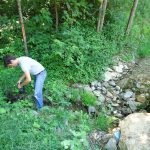Front Porch Blog
“After Bonny Blue broke loose the streams been dead…”
“No fishin’, kids can’t play, smells bad… I wouldn’t put a toe in that creek.”
“A lot of people drink tap, but I won’t, I don’t trust it.”
The first visit to St. Charles was alarming, and in many ways familiar. We’ve all read of acid mine drainage or fish kills below mine impoundment breaks. But how many of us have lived with the aftermath, day in and day out? The St. Charles creek receives waste from two massive underground mines, their associated processing plants, and slurry impoundments. Now, older folks long for the days before the mines when you could fish, swim, drink straight from the creek.
 Lee County, Va. isn’t heavily mined, unlike Wise County which is right next door. The communities of St. Charles and Keokee are the exceptions in Lee County. The tucked away towns were always comforting when I visited; driving through Virginia backroads over mountains and around tight switchbacks is almost meditative. Despite the lull of summer’s heat and the drive’s beauty I would always be heading to another murky pond, orange seep or dead stream below burdensome surface mines. In St. Charles, I was visiting folks to hear more about the two 1996 slurry impoundment spills and see if I could help by testing the water. After a few hours of stories and a couple of monitoring trips it’s plain to see that coal inevitably hurts those living downstream.
Lee County, Va. isn’t heavily mined, unlike Wise County which is right next door. The communities of St. Charles and Keokee are the exceptions in Lee County. The tucked away towns were always comforting when I visited; driving through Virginia backroads over mountains and around tight switchbacks is almost meditative. Despite the lull of summer’s heat and the drive’s beauty I would always be heading to another murky pond, orange seep or dead stream below burdensome surface mines. In St. Charles, I was visiting folks to hear more about the two 1996 slurry impoundment spills and see if I could help by testing the water. After a few hours of stories and a couple of monitoring trips it’s plain to see that coal inevitably hurts those living downstream.
Arch Coal owns the Bonny Blue Mine and Lone Mountain Mine, both of which are a couple miles upstream from St. Charles. As an intern with the Appalachian Water Watch program my main job was to test water quality below mines and train locals how to monitor mining-affected streams. I measured conductivity, temperature, pH and total dissolved solids using our program’s water quality probe. Conductivity and pH are the two most important measurements; both can indicate poor water quality and prompt further testing. For example, conductivity over 500 uS/cm (micro-Siemens per centimeter) can be detrimental to aquatic life and may violate the Clean Water Act’s narrative water quality criteria. Water pH below 6.0 or above 9.0 can’t support aquatic life and is unfit to consume.
Conductivity below the Lone Mountain Mine ranged from 478.6 to 1820 uS/cm. Even 2.4 miles downstream from the mine the conductivity was as high as 877 uS/cm. No wonder the creeks were proclaimed dead by locals. The most blatant source of pollution is the enormous slurry impoundment that constantly releases gray-black water into the St. Charles’ headwaters. I would test this discharge at a spot 30 feet away from homes and within 20 feet of the mine entrance. You see, the places with the worst pollution aren’t unpopulated. These are neighborhoods with playgrounds, summer gardens, and untouchable creeks flowing across the street from homes.
Not everything is ‘doom and gloom’ in Appalachian coal towns. Mountain communities are resilient and tight-knit, self-sufficient and simple. In St. Charles and other Appalachian towns I was always greeted with open arms; the importance of family and well-being was part of every conversation. Working on Appalachian Water Watch proved to me that mountaintop removal kills streams, that those living with the contamination are aware of that and unsettled by it, and that we can use our collective skills to restore streams back to health. Not everyone is a scientist willing to spend hours collecting and analyzing data. Not everyone can work with a new community to organize a water or dust control campaign. But we can all recognize the need for collaboration and commit to proactive change to stop mountaintop removal’s impacts on our public waters.
Volunteers are the driving force behind Appalachian Water Watch.  Trained citizen monitors have submitted over 160 water quality reports on the program website. These reports are used to enforce the Clean Water Act and track contamination events across Appalachia. If you live or work near surface mining operations and want to know how the water is impacted, please go to our website or contact us to learn more about volunteering. In light of the recent court rejection of EPA’s conductivity guidance it is even more important to increase citizen participation in protecting local waterways both in the field and at home.
Trained citizen monitors have submitted over 160 water quality reports on the program website. These reports are used to enforce the Clean Water Act and track contamination events across Appalachia. If you live or work near surface mining operations and want to know how the water is impacted, please go to our website or contact us to learn more about volunteering. In light of the recent court rejection of EPA’s conductivity guidance it is even more important to increase citizen participation in protecting local waterways both in the field and at home.
PREVIOUS
NEXT
Related News

Leave a comment
Your email address will not be published. Required fields are marked *

